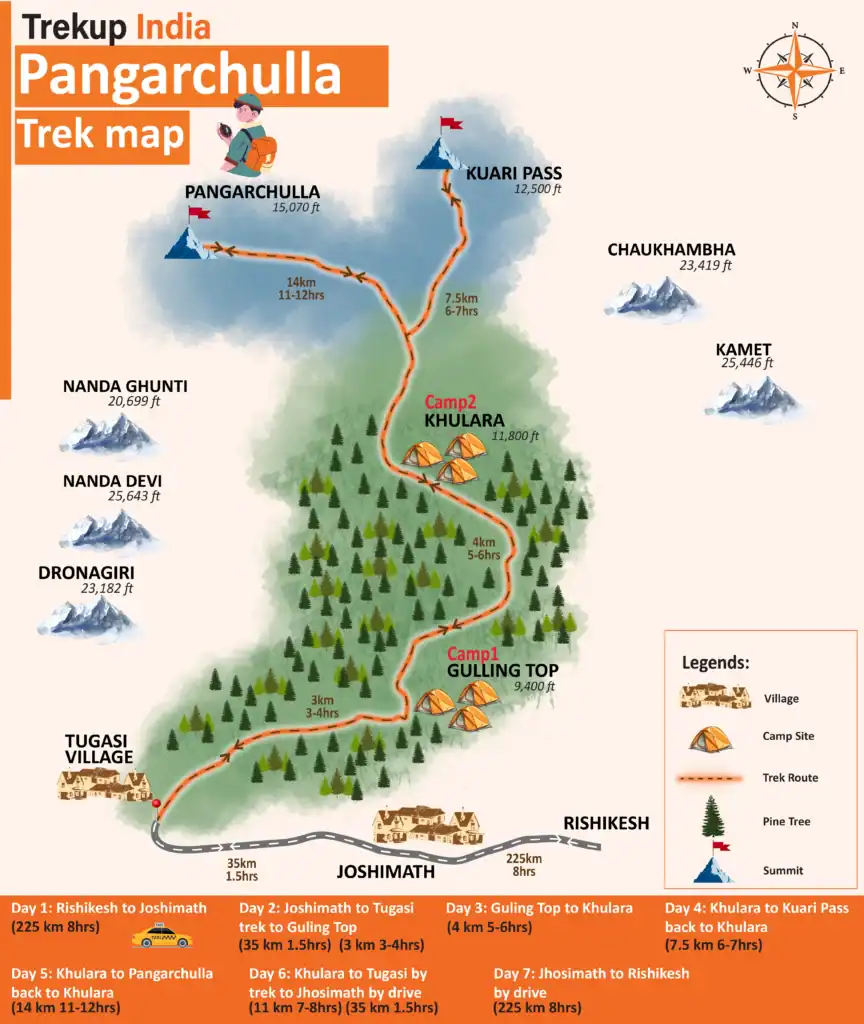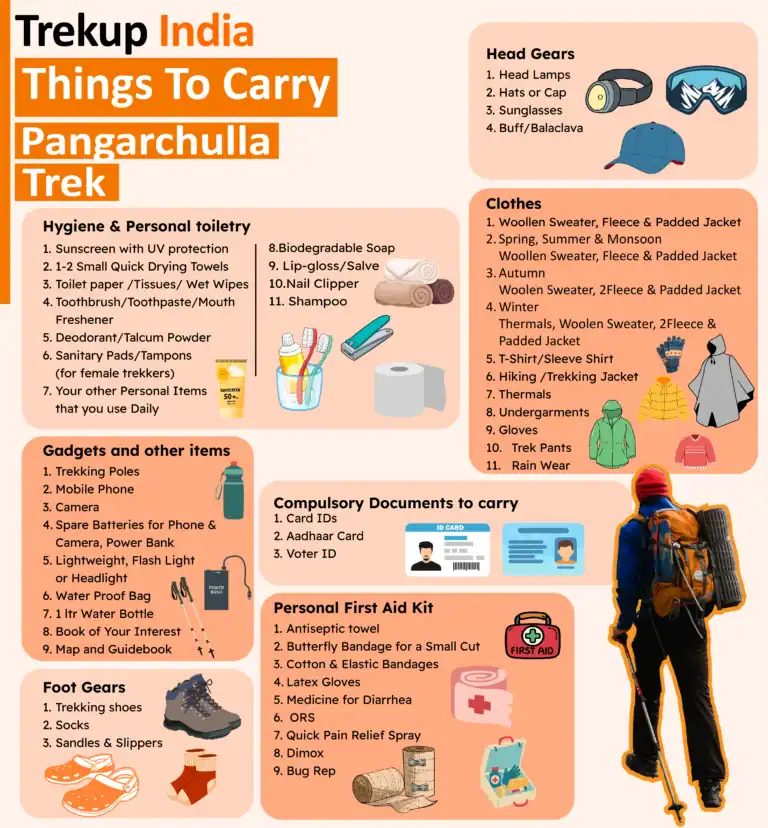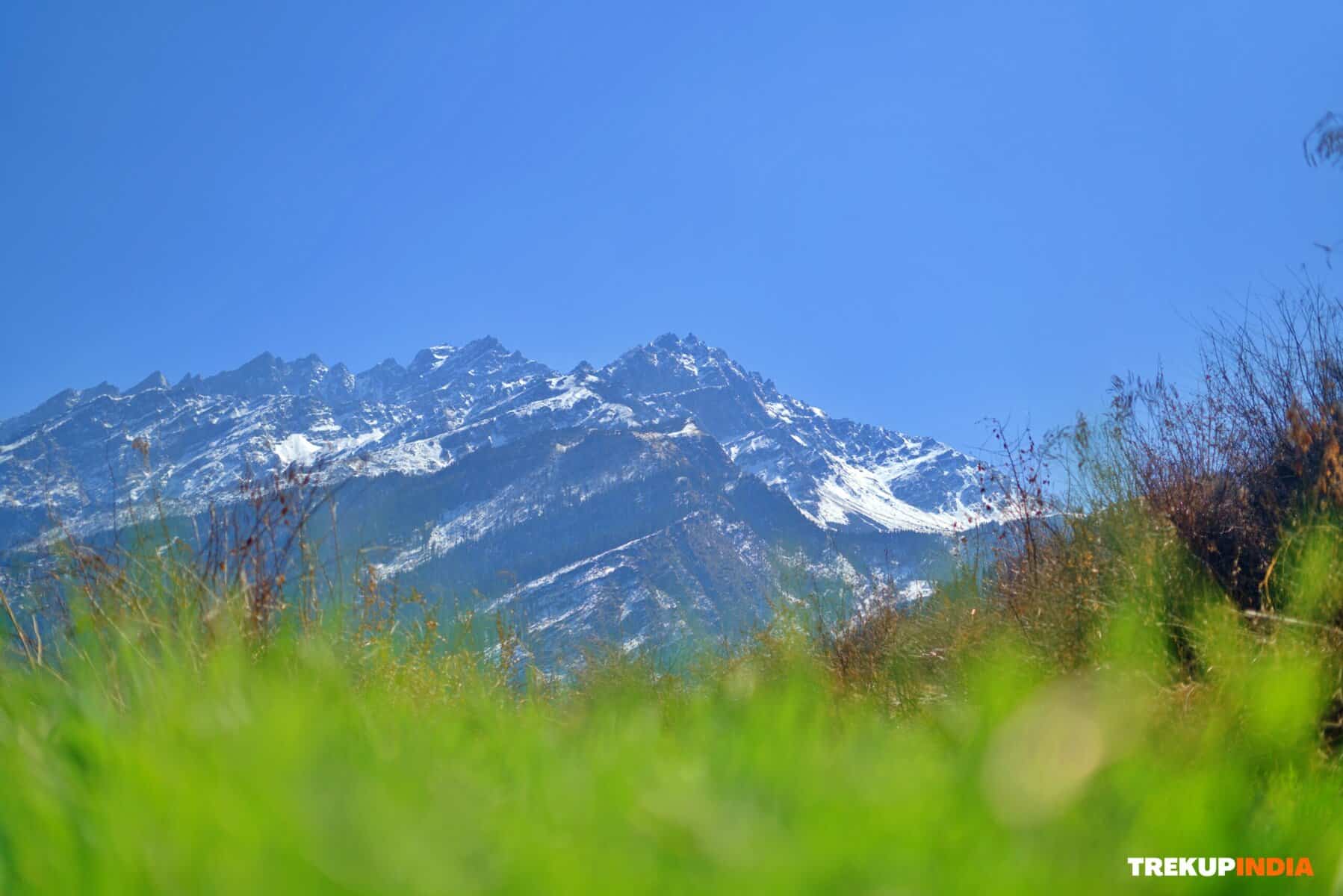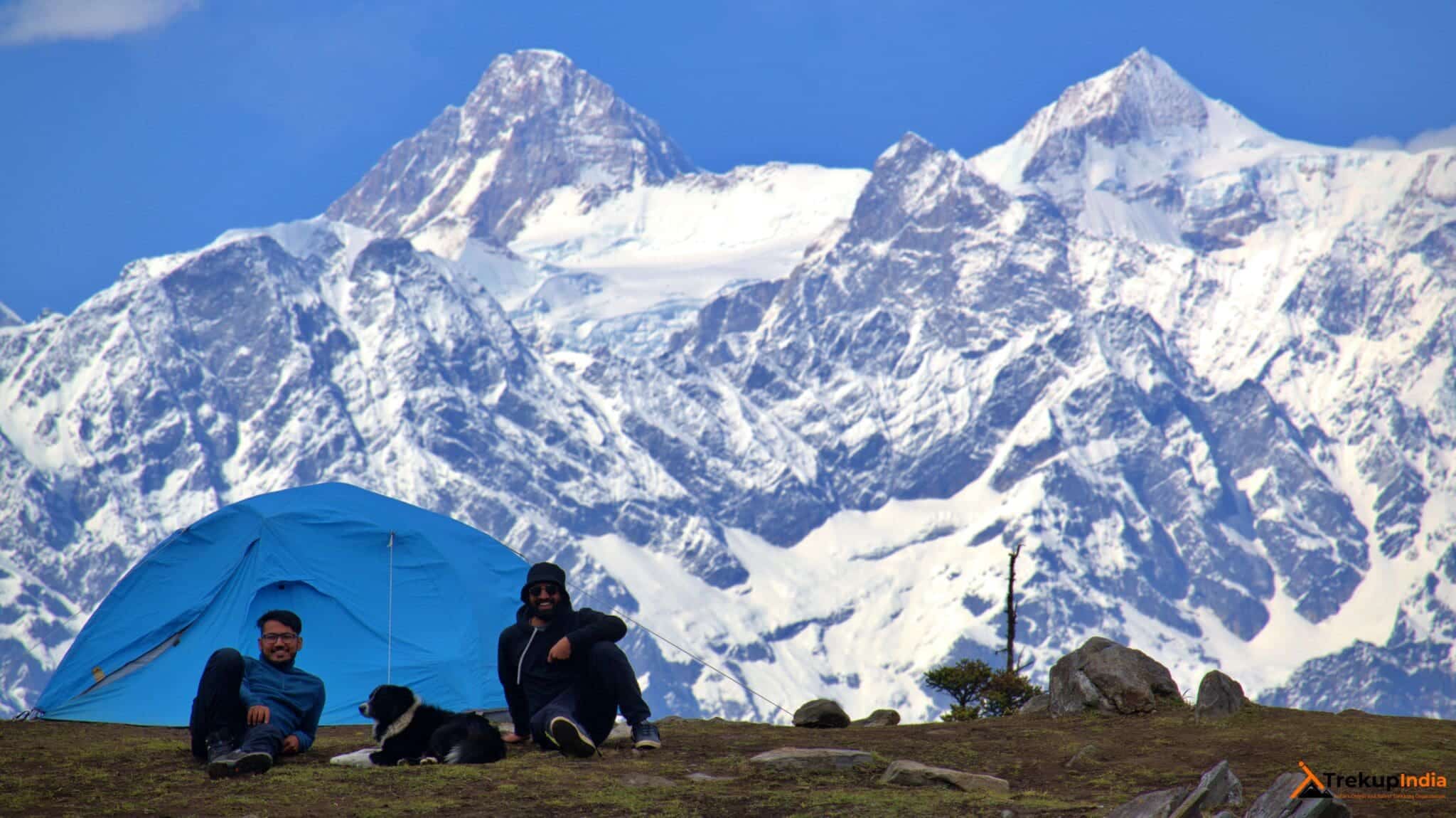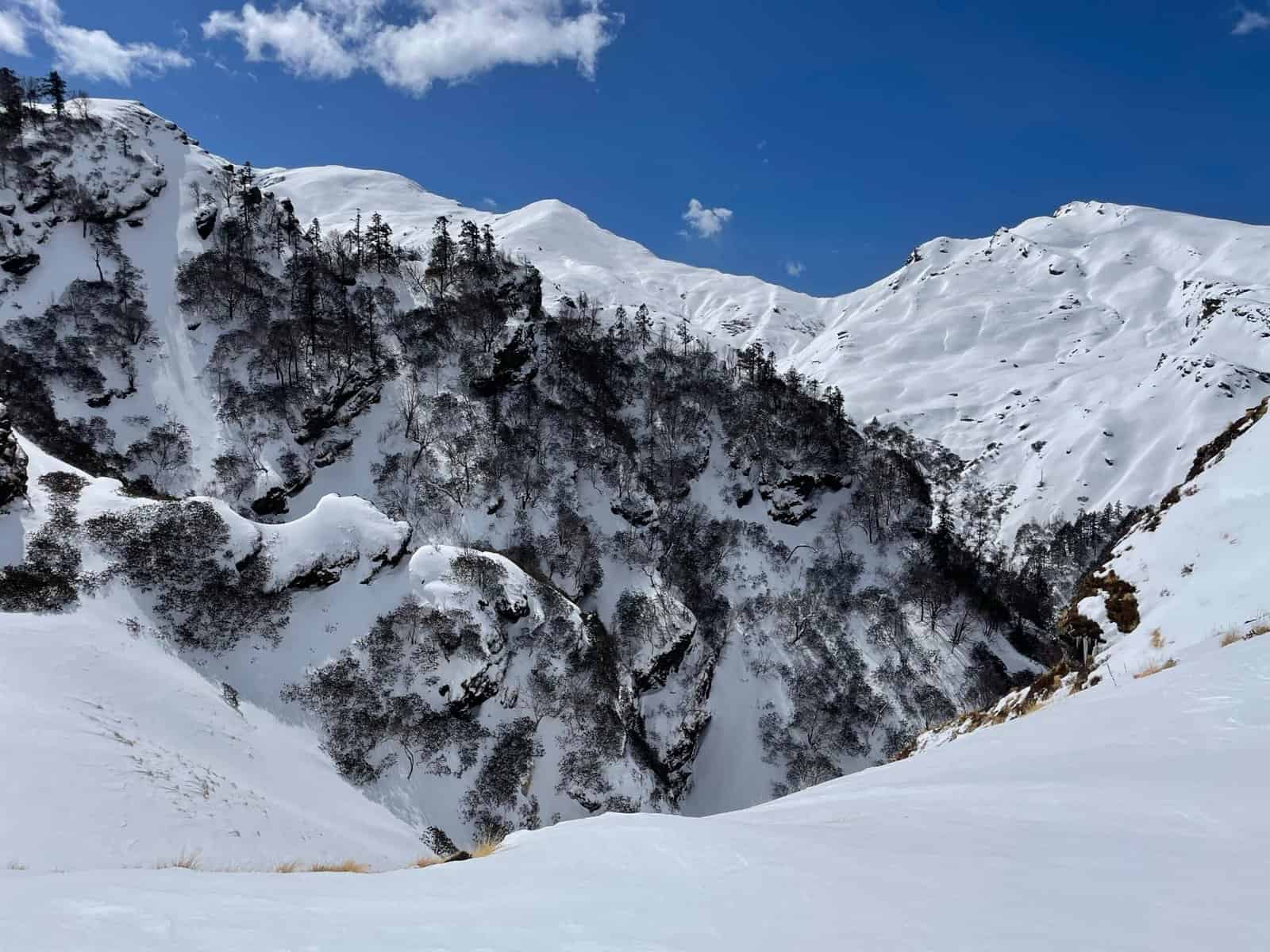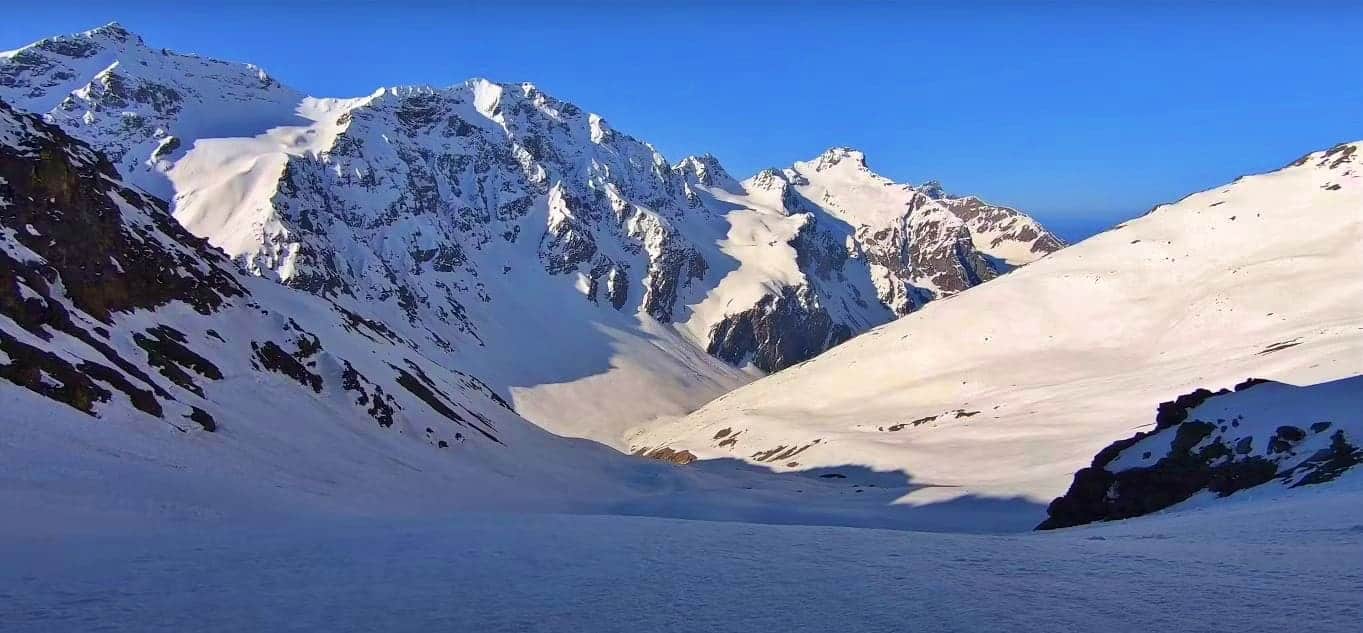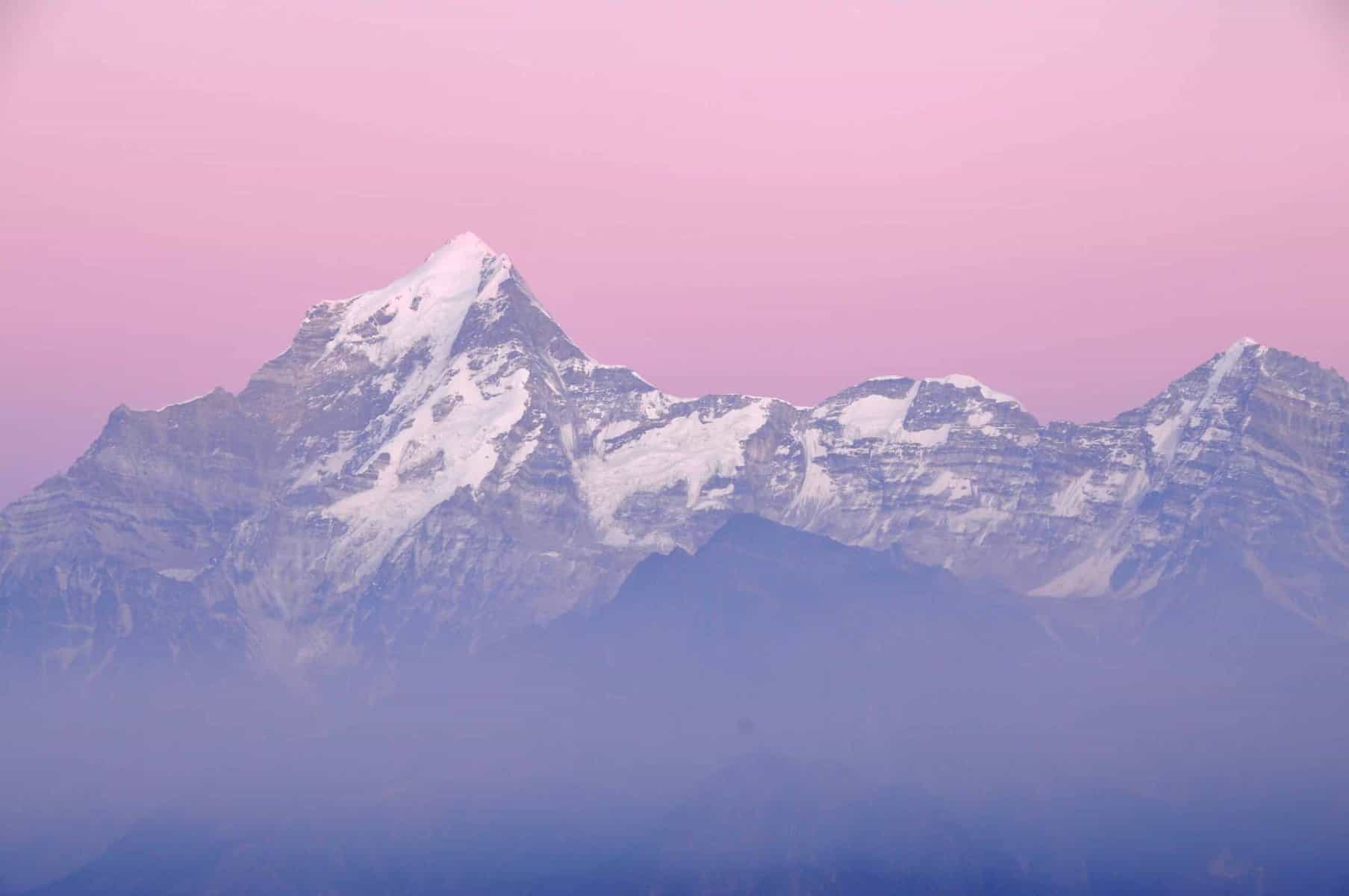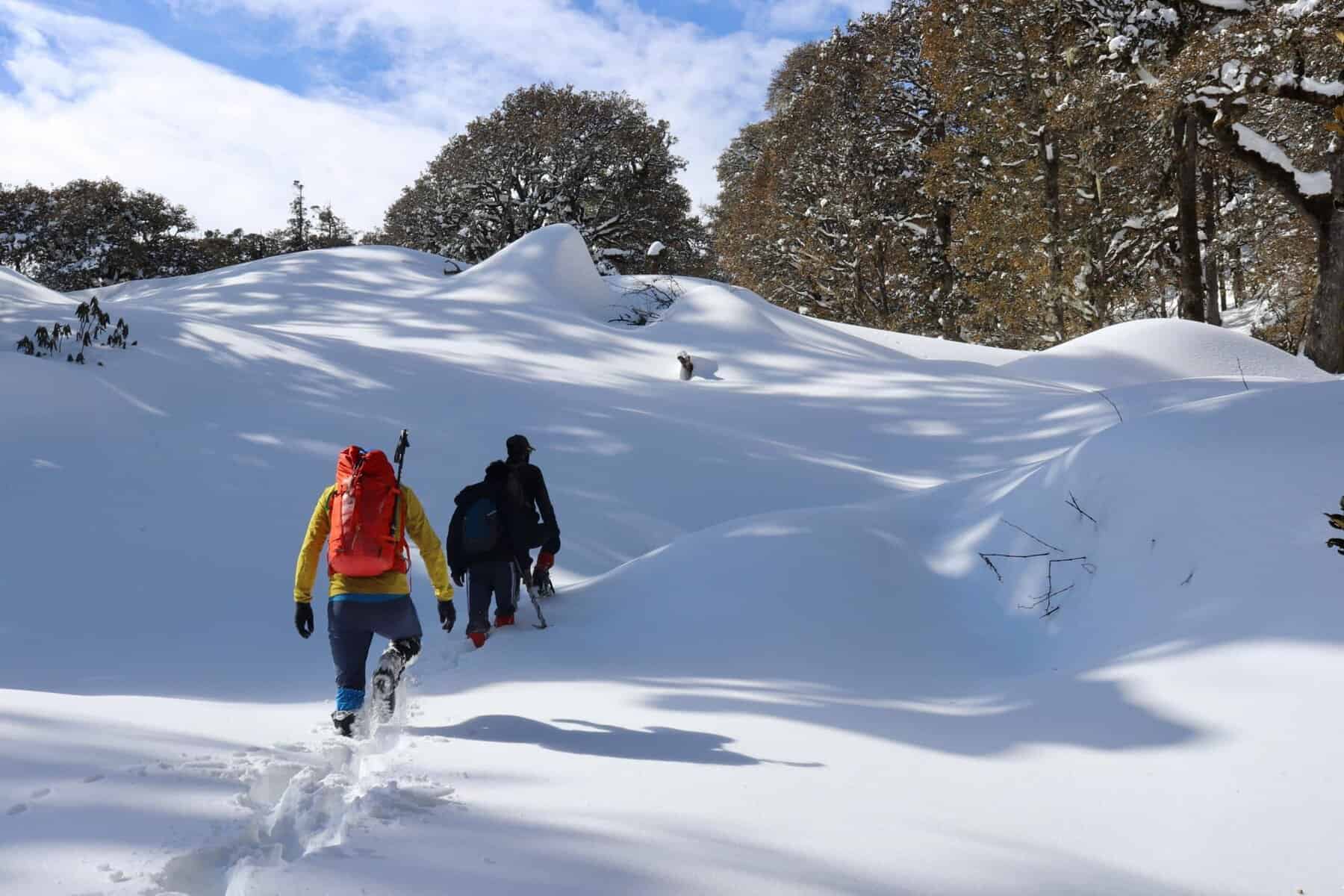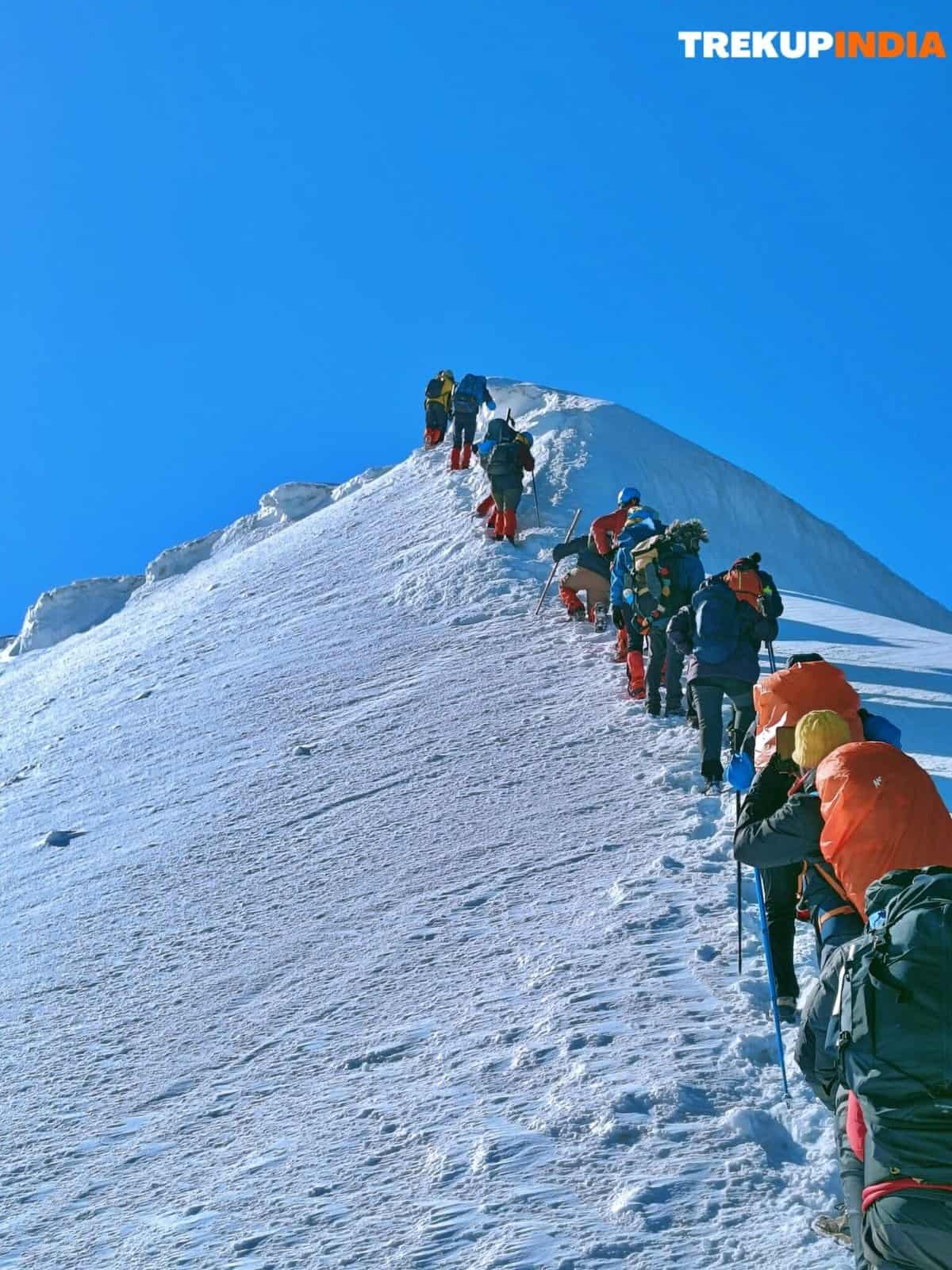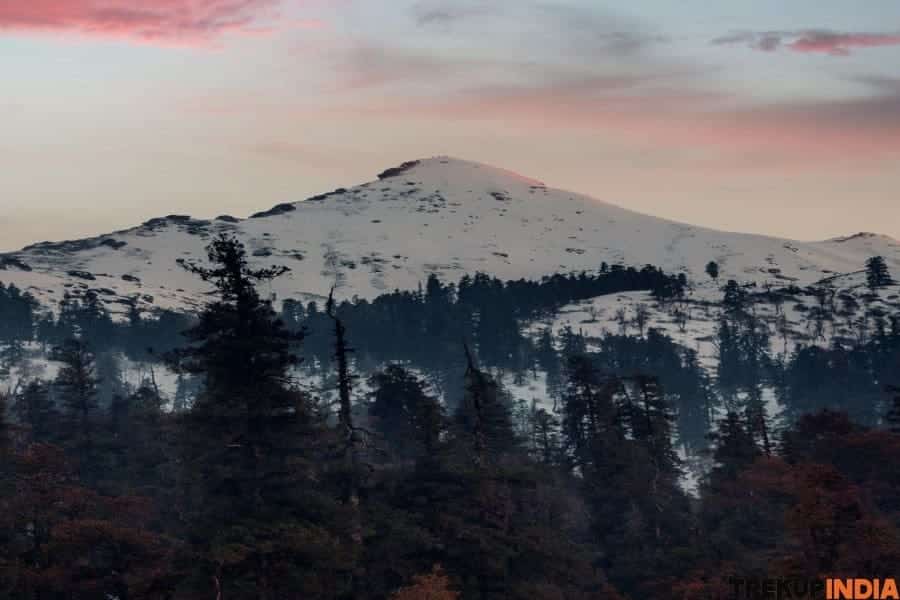30+ Years Of Trusted Trekking Expertise | Crafting Memories Since 1993
Trek Grade
Moderate
Highest Altitude
15,081 ft
Base Camp
Joshimath, Uttarakhand
Best Time
Mar & April
Trek Distance
40 Km
Not sure which trek is right for you? Trekup India’s Mountain Experts have you covered.
Not sure which trek is right for you? Trekup India’s Mountain Experts have you covered. From figuring out if a trek matches your fitness level to knowing who you’ll be trekking with, we’re here to answer all your questions. Reach out to our Mountain Experts and plan your trek with confidence.
Pangarchulla Peak Trek
The Pangarchulla Peak Trek is breathtaking, and at the same time, it has an excellent challenge to reach its summit. It offers awe-inspiring views of the Garhwal Himalayas. Standing tall at 15,069 feet, reaching the summit is a great challenge that rewards hikers with breathtaking panoramas. The Pangarchulla trek is moderate in grade and requires a good fitness level. Trekkers can marvel at the famous Garhwal Himalayan peaks on clear days, including Nanda Devi, Kamet, Hathi Ghoda Parbat, Chaukhamba, and Mana.
The trail of the Pangarchulla Peak Trek winds through dense forests, a serene world adorned with beautiful flowers and a glistening carpet of snow. It’s not just an adventure but a journey through a captivating world of tranquillity and natural beauty. The trek features stunning rhododendrons and pristine snow carpets, a sight that will leave you spellbound and yearning for more.
The best times to embark on this trek are March, April, September, and October when the weather is mild, and the slopes are stable. It’s important to note that during other times, the slopes can become unstable and dangerous, with exposed boulders posing a risk. This thrilling expedition is perfect for those seeking to test their endurance and determination while immersing themselves in the Himalayas’ stunning landscapes and panoramic views. However, safety should always be a priority, ensuring a secure and confident trekking experience.
Trek Cost
- Stay will be on a twin-sharing basis in tents
- + 250 Trek Insurance (Mandatory)
- Discount Policy
- Transport Optional ( INR - 1,600 extra )
Pickup from Natraj Chowk – Rishikesh at 6.30 A.M & will drop at same location by 7 P.M
Fix Departure Dates
Pangarchulla Peak Trek Videos
Videos by experts watch these videos to prepare well for a Successful Trek
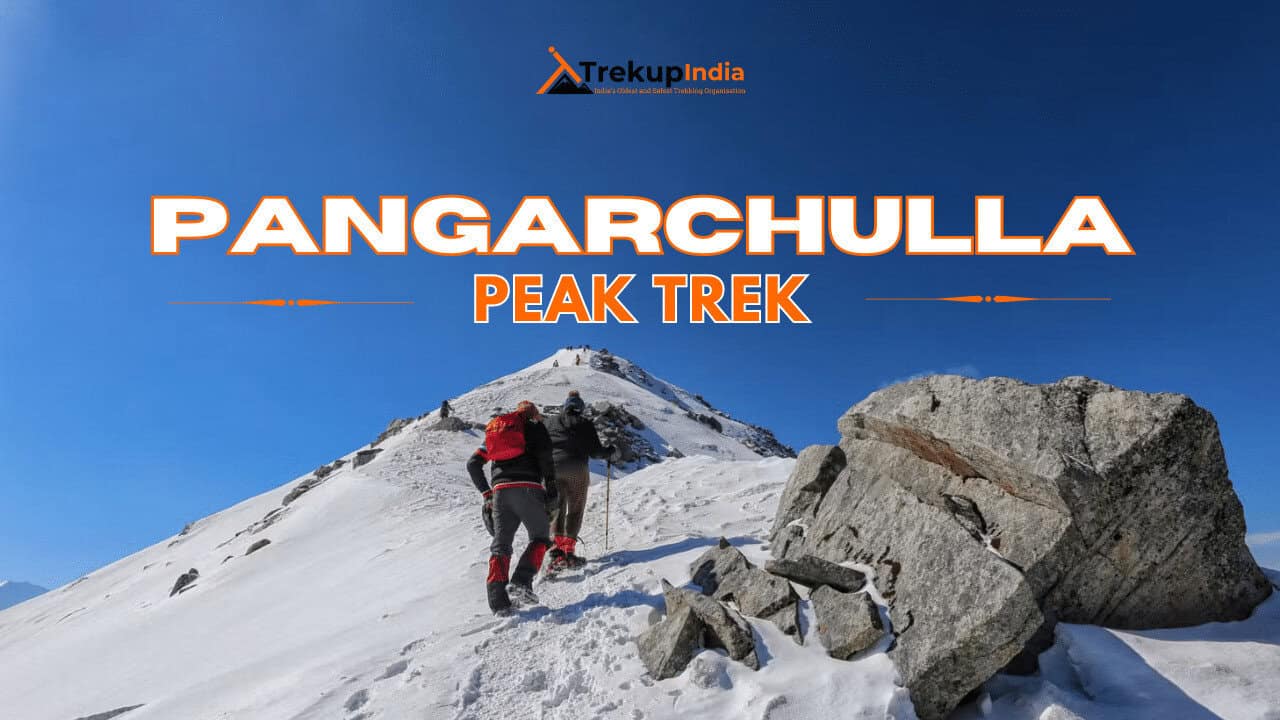
Want To Trek Like Pro?
Basically, watch these videos if you want to trek the same way professional trekkers do and make your skills better. These videos contain useful tips and techniques to further improve your trekking skills itself. These videos actually help both new and experienced trekkers improve their trekking skills. These videos definitely provide useful tips that make your trek better. We are seeing that these videos by Trekup India experts will only help you make your trekking skills better.







Know Everything About Acute Mountain Sickness
Acute Mountain Sickness occurs when people trek to high altitudes above 8,000 feet. This condition itself develops further due to reduced oxygen levels at such heights. Basically, as you go higher up, the air pressure and oxygen levels decrease, which causes the same problem. Acute Mountain Sickness surely causes headache, nausea, vomiting, and dizziness in affected persons. Moreover, peoples also experience difficulty in sleeping during this condition. To avoid mountain sickness, you should actually trek up slowly to higher altitudes. To learn further about this condition itself, watch the videos by Trekup India.



Day Wise Detailed Itinerary of Pangarchulla Peak Trek
Day 01: Rishikesh – Joshimath by drive
- Drive Duration: Approx. 8 hours
- Drive Distance: Approx. 225 kilometers
- Overnight stay at Guest House / Hotel
- Meal Dinner Only
Today’s morning pickup will be from Rishikesh at 6:30 am. The entire day will be a driving day, and meals en route will be self-purchased. A good mobile network and connectivity will be available. Overnight stay will be in a guest house or hotel provided by Trekup India.
Please report at Natraj Chowk in Rishikesh at 6:30 am, where a Trekup India representative/driver will meet you in the morning. Once everyone has boarded the vehicle, we will proceed with our day-long drive of approximately 7-8 hours to Garudganga/Joshimath. We will enjoy the incredible mountain drive, following the river Ganges until Devpryag, where it changes its name to Alaknanda. Along the way, we will pass through some significant Himalayan towns, such as:
– Devpryag: Witness the incredible confluence of the Alaknanda and Bhagirathi rivers.
– Rudrapryag: The beautiful Alaknanda River merges with the Mandakini River.
– Karanpryag: The place where the Pindar River merges with Alaknanda.
This drive is fantastic, as you will notice that five rivers merge into the River Alaknanda to eventually form the holy River Ganga, also called Panch Prayag. The five prayags are Vishnupryag, Nandpryag, Karanpryag, Rudrapryag, and Devpryag. It is believed that anyone taking a dip in these five Prayags cleanses and purifies the soul, bringing them closer to Moksha.
After a long, hectic drive, we will reach our destination, check into the accommodation, and have some time for rest. Here, we will meet with Trekup India team members, and your trek leaders will be introduced during the evening briefing.
Day 02: Joshimath-Tugasi Village by Drive and Trek to Guiling Top
- Altitude Gain: 9,600 feet
- Drive Duration: Approx. 1.5 hours
- Drive Distance: Approx. 35 kilometers
- Trek Duration: Approx. 3–4 hours
- Trek Distance: Approx. 3 kilometers
- Overnight stay at Camps in tents on twin sharing
- Meal Breakfast / Lunch / Snacks / Dinner
After breakfast, we will drive for 1.5 hours to the trek point and then start our trek to Guiling Top, gaining an altitude of 3450 feet. Water sources will be available, and there will be mild network coverage until Tugasi Village. We will have an overnight stay at Trekup India camps.
We will enjoy breakfast at our booked accommodation in the morning and then drive to Tugasi village. Upon arrival, we will get out of our vehicles and begin our trek to Guiling. The trek will mostly pass through beautiful Himalayan villages and consist of steep and gradual ascents to the Guiling top. Remember, don’t fill your water supplies while trekking through the villages to stay hydrated. You will also have the chance to meet and interact with local people, farmers, and shepherds and learn about their daily mountain life and hardships. You might hear some local mountain stories. We will likely reach our campsite to enjoy a hot lunch at Trekup India’s campsite. After checking into our camps, we can stroll around the campsite to capture views of the great Himalayan peaks, including Doronagiri, Hathi Parvat, Guari Parvat, and others. Later, we will enjoy tea, snacks, and dinner at the campsite and prepare for the next trek.
Day 03: Guiling – Khulara (11800 Ft.) by Trek
- Altitude Gain: 11,800 feet
- Trek Distance: 4 Kms
- Time Duration: Approx. 5-6 Hrs
- Overnight stay at Camps in tents on twin sharing basis
- Meal Breakfast / Lunch / Snacks / Dinner
Today, enjoy a gradual, steep trek to Khulara, gaining approximately 2200 Feet. Do carry 2 litres of water, as this day you might not get a water source. Do not expect connectivity; leave yourself in nature. Spend a beautiful night in Trekup India.
Wake up to a beautiful mountain morning with a cup of black tea, gazing at mighty sun rays over the vast mountains. After a warm breakfast, we prepare for a stricter day trek to our next destination. The trek passes through the beautiful oak, Rhododendron and wall nut forests. Trekking through the forest means a greater chance to spot different species of birds; it can be a paradise for birdwatchers; hence, binoculars will benefit enthusiasts. On the other hand, keep a close watch on spot wild animals. We will get natural water sources to fill our bottles and keep our bodies hydrated. The Khulara campsite offers even better & more mountain views than the first campsite; some of the peaks visible are Doronagiri, Kamet, Kedarnath Peak, Kedar Dome, Chaukhambha, Mana I, Nanda Devi, Nanda Ghunt and others. We make it to the campsite for lunchtime, enjoy a hot lunch, and spend some time regaining and conserving our energy for the upcoming challenging destination. You may ask your trek leader to demo how to pitch the tent and learn some mountain survival skills.
Day 04 Khulara – Kuari Pass – Khulara by Trek
- Altitude Gain: 12500 feet
- Trek Distance: 7.5 Kms
- Time Taken: Approx 6-7 Hours (both way) Day for making it to Kuari Pass summit by gaining an altitude of 700 Ft. through Lord Curzon Trail.
- Overnight stay in tents (twin sharing)
- Meal Breakfast / Lunch / Snacks / Dinner
This morning, wake up to the freshness of the mountains and see the golden rays of the sun on these pretty mountains; if you feel like doing this, leave yourself in the lap of nature and meditate for 10-15 minutes. Enjoy cooked breakfast at the campsite, and after that, along with us, our expert Trek leaders, we proceed our trek to Kuari Pass; the trail passes through the Oak and Rhododendron Forest; enjoy the chirping of birds, best for Birdwatcher (Do not forget to carry your binocular), after walking through the forest the landscape changes to beautiful mountains views. After an hour, we will follow the Lord Curzon train towards Kuari Pass; after walking for 30-40 Minutes, we will come to a view spot, where we have an opportunity to witness incredible views on clear days of Chaukhambha, Neelkanth Peak and other peaks. Will we start Steff ascending to Kuari Pass peak at 12500 Ft. Do not forget to energize yourself with Nutri / energy bars (you must carry some), as well make sure your water bottles are filled to keep you hydrated and unique care against harsh sun is required, hence be prepared with a Sun hat and sunscreens. After spending quality time at Kuari Pass’s summit, we descend the same route to our Khulara campsite. Evening in leisure time for rest, relaxation, and getting ready for another stricter day.
Day 05: Khulara to Pangarchulla then back to Khulara by Trek
- Trek Distance: 14 Kms(Both Way)
- Time Taken: Approx 11- 12 Hours (both way)
- Overnight stay at Camps in tenyts on twin sharing
- Meal Breakfast / Lunch / Snacks / Dinner
- Finally, the final summit has come, we will start early in the morning, the day might be tiring as it will be steep climb on snow / boulders and straight gaining 3269 Ft. Carry enough water for the day.
Today morning we start early in the morning today (Between 3-4 am); get yourself prepared for the day, as all efforts and hard work are going to be utilized here; we are sure that by today, your body will be fully prepared for some steep and rigid step, though you will be exhausted, in the end, you will feel it worth and one of the best moment for your life, that you will cheer for a lifetime. Though the scenery experience will be unique as the views and landscape change from ethereal forestation to vast open meadows, the pretty blue skies and the empty land can be seen till your vision reaches. Finally, after a 6 hours body tiring climb to Pangarchulla summit at 14700 Ft. and, a vast, magnificent 360 degrees of Garhwal mountains greet you with its beauty; you will just be mesmerized by the never-before-seen beauty; it blows your mind & soul to just another level. Our advice is to sit for 5-10 minutes, close your eyes, meditate & feel nature, the sound, the freshness, and talk to your soul like you are in a different world. Have an opportunity to witness some of Garhwal’s high peaks, such as Kedarnath, Kharchakund, Chaukhamba, Parvati Parbat to the West, Avalanch Peak to the North, Kamet, Mana and many more. The river gorge of Rishi Ganga, Alaknanda, Dhauli bounds Pangarchulla. Later, after completing the summit with excitement, we returned to the Khulara campsite and enjoyed hot tea and snacks, followed by dinner.
Day 06: Khulara –Tugasi by Trek – Joshimath by Drive
- Trek Distance: 11 Kms
- Trek Duration: Approx 7-8 Hrs
- Drive Distance: 35Kms
- Drive Duration: Approx 1.5 Hrs
- Overnight stay at Camps
- Meal Breakfast / Lunch / Snacks / Dinner
- Following back same route we trek on a steep descend to Tugasi and there after drive to Garudganga for an overnight stay at Trekup India accommodation, followed by certificate ceremony.
After a leisurely breakfast at Trekup India campsite this morning, we will return to our hotel in Joshimath. From Khulara, we trek until the Tugasi road head, following the same route we have trekked up. On this day, you will have the final chance to witness the fantastic nature and mountains you will miss in your cities. On arrival at your accommodation, it is time to freshen up. Later, we will have a certificate ceremony.
Day 07: Joshimath – Rishikesh by Drive
- Drive Distance: 225 Kms
- Drive Duration: 7 Hrs
- After having tea or coffee, we will depart to Rishikesh from Joshimath.
- You will be reaching Rishikesh in the evening around 6 to 7 PM.
- Get your bookings and tickets done accordingly.
- You can also do the tickets for your hometown after 8:00 PM
- No Accommodation
- Meal Breakfast Only
Today morning, after breakfast we board our vehicles and proceed our drive to Rishikesh, reaching in the evening hours between 18:00-19:00 Hrs. So, make your onwards plans accordingly.
Pangarchulla Peak Trek Route Map
We’ve prepared a comprehensive Trek Route Map for your upcoming adventure to Pangarchulla Peak Trek, which outlines the entire journey including all stops and trails. This map provides detailed information on the terrain, distance between points of interest, and estimated travel time to help ensure a safe and enjoyable trek. We’ve carefully curated the map to ensure that you have all the necessary information at your fingertips. Please take a moment to review it thoroughly, and don’t hesitate to reach out if you have any questions or concerns.
Pangarchulla Peak Trek Altitude Chart
The Pangarchulla Peak Trek Altitude Chart is a useful tool for Trekkers to monitor their altitude changes during their rides, allowing them to plan their routes more efficiently and track their progress over time. This Pangarchulla Peak Trek chart is beneficial for both casual and experienced Trekkers, helping them make the most out of their Trek experience.
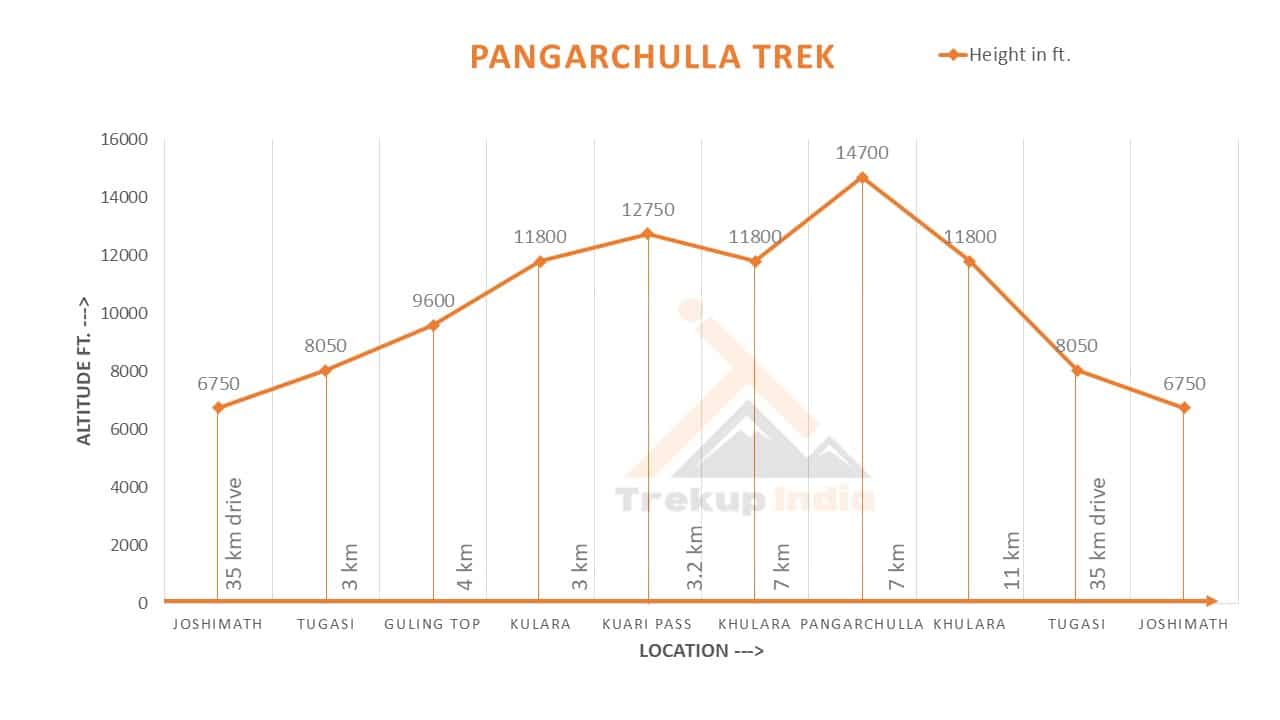
Trek Cost Inclusions
- Stay: 4 Nights of tented accommodation at individual campsites of Trekup India on twin sharing and 2 nights of hotel, guest house on sharing basis.
- Meals: Trekup India will provide freshly cooked meals during the trek starting with Dinner on Day 1 to tea, coffee on day 7 (Meals are simple, nutritious, and vegetarian)
- Transport (Optional): Rishikesh to Joshimath and return. ( 1600 extra )
- Trek Insurance (Optional): Trekup India recommends that all trekkers consider getting trek insurance. This is optional, but highly recommended. Trek insurance covers unexpected events that may occur during your trek. The cost of the insurance starts from INR 210. This expense is not covered in the cost of the trek. Please read more about what is included in the coverage and why it is mandatory on treks.
- Trek Equipment: Sleeping bag, Sleeping tents, Kitchen tent, Dining tent, Toilet Tent.
- Amenities: All utensils, sleeping mattresses (Black foam mats), Crampons, and Gaiters for snow.
- Health & Safety: First Aid Box, Oxygen Cylinders, Stretchers, Oxi meters, BP Machines, health.
- Permits: Forest Permits and Camping Permission Fee
- Trek Crew: High Altitude Chef, Helpers, Trek Leader & Guides, and other support teams.
- Potters & Mules: Potters and Mules are to carry all trekking equipment, ration, and vegetables.
Trek Cost Exclusions
- GST 5% (it is Mandatory)
- Any Meals/accommodation beside the itinerary or not mentioned in the program.
- Any Bus / Airfare to/from trek start/end point
- Personal Medical expenses do carry your medication.
- Any personal services such as Laundry, phone calls, liquors, mineral water, etc.
- Any still / video camera fee
- Any Entrance fee Monuments, Monasteries, Museums, Temples – Pay directly on the spot.
- Backpack Offloading (Mule/Porter Charges)
- Offload Charges: ₹2520 per bag for the full trek if paid online in advance.
- On-spot Payment: Charges may increase by up to 30% if paid at the base camp.
- Weight Limit: Each bag must not exceed 10 kg.
- Note: Offloading is optional and is recommended for those who prefer to trek with a lighter daypack.
- Any emergency evacuation charges
- Any services that are not mentioned in the cost inclusion section.
What should you pack for the Pangarchulla Peak Trek
Pangarchulla Peak Trek is a high-altitude trek. The trekking gear you have to have for this particular trek differs from normal treks. Thus, read this whole segment. There is an important question that the trekker who is doing trek asks, like what all things to carry while trekking. Below, we have provided the details on everything you should take; an easy way to remember is by Head to foot or foot to head. We have prepared from Head to foot.

Head Gears
When trekking it's important to carry headgear to protect your head and face.
Heading out for a trek? Don’t forget to carry headgear to protect your beautiful face and head from the sun, wind, and dust! It’s an essential accessory that keeps you safe and comfortable throughout your adventurous journey. So, make sure you pack it before you step out into nature!
- Head Lamps – When trekking at night, headlamps are essential to illuminate your path while keeping your hands free. Headlamps come in different sizes and lumens, so it is essential to choose one that suits your needs.
- Hats or Cap – Caps or hats are also necessary when trekking in different weather conditions. Caps protect your head from the wind and freezing temperatures at night, while hats provide shade and protection from the sun during the day. It’s essential to ensure that your hat has a strap to prevent it from being blown away by the wind.
- Sunglasses – Sunglasses are also essential for trekking. Your sunglasses should protect your eyes from harmful UV rays and fit your face perfectly to avoid falling off while climbing, jumping, or crossing obstacles. The glass of your sunglasses should also be designed for different weather conditions to provide optimal visibility.
- Buff / Balaclava – Lastly, a buff or balaclava is a must-have to protect your mouth or neck from extreme temperatures and keep them warm. Buffs and balaclavas come in different materials, thicknesses, and designs, so it’s important to choose one that suits your needs and preferences. Depending on the weather conditions and your activities, you can wear them as neck warmers, face masks, or headbands.
Clothes
When trekking in high altitudes, prepare for cold weather by wearing layers. Layering traps heat, keeps you warm, and allows you to easily adjust your clothing as temperatures fluctuate.
Layering is important for different seasons when trekking. When planning a high-altitude trek, it is important to prepare for the cold weather. Wearing layers is the best approach as it provides both protection and flexibility when the weather changes frequently in the mountains. Layering helps to trap heat and keep your body warm, while at the same time allowing you to easily adjust your clothing as the temperature fluctuates. By wearing layers, you can enjoy your trek comfortably and stay safe in the unpredictable mountain weather
- For spring, summer, and monsoon treks, consider wearing three layers: a woollen sweater, a fleece, and a padded jacket.
- For autumn treks, add one more fleece layer to make it four layers.
- For winter treks, you may need five layers with thermals, a woollen sweater, two fleeces, and a padded jacket.
- T-shirt/sleeve shirt– Bring three T-shirts and two quick-dry trek pants, wearing one and carrying the others. Long sleeve shirts help to protect from sun UV rays. We recommend synthetic T-shirts as they get dry quickly when they get wet.
- Hiking / Trekking Jacket– down jackets (-5 to-10 C) or two-three-layer jackets.
- Thermals– at least two pairs of thermals help keep the body warm during cold weather.
- Undergarments– you can carry them according to your habitual and hygiene requirements.
- Gloves– 1 pair of gloves will keep your hand warm and nice.
- Trek Pants– Bring 2 to 3 comfortable trekking pants. Trekking pants play a significant role, as they are designed for comfort and mobility, making trekking easier. It should be Synthetic so that it gets dry quickly when wet.
- Rain Wear– you can carry a raincoat or Poncho. During long rains and snowfalls, the waterproof jackets start leaking. Still, the Poncho and raincoats keep you dry, so choose accordingly.
Tip: If you choose a raincoat on your trek, carry a small waterproof cover so things inside your backpack can’t get wet. If you carry a Poncho, you don’t need to worry. It protects both you and your backpack.
Foot Gears
When it comes to planning a trek, one of the most important aspects is to ensure that you have the right kind of foot gear.
- Trekking shoes which are waterproof and have ankle support. Walking / Hiking sandals which can be used off the trek, i.e., in the morning and evening hours when you reach the campsite, basically to get your feet rest from heavy boots, sometimes used for crossing streams and rivers, it’s more comfortable and safer than crossing barefoot or wetting your shoes. Sneakers (Optional) can be worn for normal driving days or used around the camp.
- Socks– you should at least carry 3 to 4 pairs.
- Microspikes & Gaitorswill be provided by Trekup India when required. You don’t have to carry them.
Personal First Aid Kit
Don't forget to pack your personal first aid kit! It's always better to be safe. So, make sure you're prepared for any unforeseen circumstances.
Below are some common medicines generally required/used during your adventure trip; however, please consult your doctors prior.
- Antiseptic towel or water syringe (to clean the wound)
- Butterfly bandage for a small cut
- Cotton and elastic bandages and sterile gauze pad for larger wounds
- Latex gloves are used when the wound bleeds.
- Medicine for Diarrhea (Upset stomach)
- Medicine for cold, flue/fever, headache
- Some pain killers
- ORS pouches
- Quick pain relief spray (External use)
- Any personal medicine prescribed by your doctor
- Dimox / Similar for high altitude sickness
- Bug Repellent
- Carry some nutria/energy bars and drinks (non-alcoholic)
- Note: Kindly consult your doctor before purchasing or taking any medicine.
Gadgets and Other Items
You might also consider bringing a camera, binoculars, portable charger, and snacks. Be well-prepared and tackle any trail with confidence.
- Trekking Poles
- Mobile phone
- Camera
- Spare batteries for phone and camera, power bank
- Lightweight flashlight or headlight
- A waterproof bag made of plastic is used for the camera.
- Plug/converter for electrical items
- 1-litre water bottle
- A journal with a pen would be a good idea to keep your notes.
- Some book of your interest for the ideal time
- Get into the habit of maintaining a Map and guidebook of the region.
Hygiene & Personal toiletry
Remember to pack hygiene and personal toiletry items such as soap, shampoo, toothbrush, toothpaste, deodorant, and toilet paper.
- Sunscreen with UV protection to shield your skin from harmful rays
- 1 or 2 small quick-drying towels to help you dry off quickly in case of rain or sweat
- Toilet paper, tissues or wet wipes for maintaining hygiene while on the trek
- Toothbrush, toothpaste, and mouth freshener to keep your mouth clean and fresh throughout the journey
- Deodorant or talcum powder to help you stay fresh and odor-free, especially during hot and humid climates
- Shampoo to keep your hair clean and healthy
- Sanitary pads or tampons (for female trekkers) to manage menstrual cycles
- Lip-gloss or salve to protect your lips from dryness and chapping
- Bio-degradable soap to keep yourself clean and hygienic while on the trek
- Nail clipper and other personal items that you use daily
Compulsory Documents to Carry
There are certain documents that you should always carry with you. These documents are not only necessary for your safety and security, but they may also be required by local authorities.
These files must be submitted to the Forest Department before your trek. With none of these, you will not be permitted to trek—original and photocopy of government photo identity card. Carry IDs like Aadhaar, voter ID, etc.
How To Plan Your Trek & Reach Rishikesh?
To get to Rishikesh which is a well-known place to visit located in Uttarakhand, India, known for yoga, spirituality and adventurous activities, here’s the best travel alternatives:
By Air – Nearest Airport: Jolly Grant Airport (Dehradun)
- The Jolly Grant Airport is located about 20-25 kilometers away from Rishikesh (it will take 30-45 miniutes to reach Rishikesh).
- Regular flights are available from Delhi, Mumbai, and Bengaluru.
- from Delhi: 1hr flight. Taxis are available to Rishikesh from Aiport.
- International travelers: Travel to the Delhi’s Indira Gandhi International Airport (DEL) & Then take a train/flight/bus that connects to Rishikesh.
By Train – Take Train to Haridwar Junction (HW):
- And then take bus/taxi to Rishikesh (42 km away from Rishikesh (1-hour journey).
- Haridwar is connected well by railway to major cities like Delhi, Mumbai, Bangalore and Kolkata.
By Road – From Delhi:
- Buses with AC or non-AC regular service departing from ISBT Kashmere Gate (6-8 hours; between Rs500 and 1,500).
Reach Dehradun & then take taxis and buses to Haridwar. (50kms & 1 hour drive in normal traffic)
Fitness Required & Preparation Guide For Pangarchulla Peak Trek
If you’re preparing for a Pangarchulla Peak Trek, Trekup India recommends jogging as part of your fitness routine. Jogging helps work out the same muscle groups that you’ll use during trekking and can help you build endurance. You don’t need any special equipment to get started.

Fitness Target
Trekup India has put the Pangarchulla Peak Trek into an moderate grade-level trek.
For Moderate Treks – In order to be well-prepared for your upcoming trek, it is recommended that you focus on building your endurance by aiming to cover a distance of 4.5 kilometers in less than 40 minutes. This will help you to develop the necessary stamina and strength required to successfully complete your journey.
How to Achieve This Fitness Target?
To start preparing for your trek:
- Try jogging for at least five days every week.
- If you find 5 km too difficult at first, begin with 2 km and gradually increase over 2-3 weeks.
- Once you feel more comfortable running 5 km, focus on improving your speed gradually on a daily basis.
It is important to ensure that you can consistently complete 4.5 km in under 40 minutes for at least two weeks before your planned trek. Allow yourself 6-8 weeks to prepare physically for the journey.
Strength Training exercises that benefit Trekking
Trekking is an activity that demands a good level of strength.

Trekking is a demanding activity that requires good cardiovascular endurance, muscular strength, and overall fitness. To help you prepare for your trek, incorporating bodyweight exercises into your training routine can be an effective way to build strength, improve stability, and enhance endurance, all of which are crucial for a successful trek. In this regard, here’s a breakdown of body weight exercises categorized by the specific body parts they target and the benefits they offer during trekking.
1. Lower Body Exercises
Lower body exercises like squats and lunges are great for building lower body strength, essential for trekking.
a. Squats
Squats are an excellent exercise for building lower body strength, essential for trekking. They target the quadriceps, hamstrings, glutes, and calves. Solid quadriceps and glutes provide power for ascending and tackling uphill climbs, while vital hamstrings aid stability during descents. This is particularly helpful in navigating uneven terrain during trekking.
How to perform Squats Exercises:
- Stand with feet shoulder-width apart, toes pointing slightly outward.
- Lower your body by bending your knees and hips, keeping your back straight.
- Lower until your thighs are parallel to the ground or as low as comfortable.
- Push through your heels to return to the starting position.
b. Lunges
Lunges target the quadriceps, hamstrings, glutes, and calves. They improve lower body strength, balance, and stability, crucial for maintaining control on rocky trails and steep slopes. Additionally, they enhance flexibility, reducing the risk of injury while trekking.
How to Perform Lunge Exercises:
- Stand with feet hip-width apart, hands on hips or sides.
- Take a step forward with one foot, lowering your body until both knees are bent at 90-degree angles.
- Push through the heel of your front foot to return to the starting position.
- Repeat on the other side, alternating legs.
2. Upper Body Exercises
Upper body exercises such as push-ups and pull-ups effectively strengthen the upper body, especially the chest and shoulders, which are essential for carrying a backpack during treks.
a. Push-Ups
Targets: Chest, shoulders, triceps, and core.
Benefits for Trekking: Push-ups are an effective exercise to strengthen the upper body, especially the chest and shoulders, essential for carrying a backpack during treks. Improved upper body strength will also help maintain posture and stability while traversing challenging terrain.
How to Perform Push-Ups Exercises:
- Start in a plank position with hands shoulder-width apart and body in a straight line from head to heels.
- Lower your body by bending your elbows until your chest nearly touches the ground.
- Push through your palms to return to the starting position.
- Keep your core engaged throughout the movement.
b. Pull-Ups/Bodyweight Rows:
Targeting the back, biceps, and shoulders can significantly benefit trekking. You can strengthen these muscle groups by performing pull-ups or bodyweight rows and improve your posture and balance while carrying a backpack. Additionally, more muscular back muscles can help reduce the risk of back strain and fatigue during long treks, making your journey safer and more comfortable.
3. Core Exercises
Core exercises like planks and Russian twists can help strengthen the core muscles, which are crucial for maintaining stability and balance while trekking on uneven terrain.
a. Planks
Targets: Abdominals, obliques, and lower back.
Benefits for Trekking: Planks are an effective exercise that helps strengthen the core muscles. These muscles are crucial for maintaining stability and balance while trekking on uneven terrain. A strong core also helps improve posture, reducing the risk of back pain and fatigue during extended hikes.
How to Perform Planks Exercises:
- Start in a plank position with elbows directly under shoulders and body in a straight line from head to heels.
- Engage your core and hold the position, avoiding sagging or arching the back.
- Keep breathing steadily and hold for the desired duration.
b. Russian Twists
Targets: Obliques, abdominals, and lower back.
Benefits for Trekking: Russian twists engage the core muscles, particularly the obliques, improving rotational stability and balance. Enhanced core strength helps prevent injuries and improves overall performance during trekking.
How to Perform Russian Twist Exercises:
- Sit on the ground with knees bent and feet flat, leaning back slightly to engage the core.
- Clasp hands together and twist the torso to one side, bringing the hands towards the ground beside the hip.
- Return to the centre, then twist to the other side.
- Continue alternating sides for the desired number of repetitions.
4. Full Body/Cardiovascular Exercises
Full-body/cardiovascular exercises like burpees and mountain climbers are excellent for improving cardiovascular endurance, strength, and agility.
a.Burpees
Burpees are an excellent full-body exercise that targets your legs, chest, arms, and core. This exercise dramatically benefits trekking enthusiasts, improving cardiovascular endurance, strength, and agility. Regularly incorporating burpees into your workout routine can enhance your overall fitness level, which can help you endure long hikes and rugged terrains with ease.
How to Perform Burpees Exercises:
- Start in a standing position.
- Squat down and place hands on the ground.
- Jump feet back into a plank position.
- Perform a push-up.
- Jump feet back to the squat position.
- Explosively jump up into the air, reaching overhead.
- Land softly and repeat the sequence.
b. Mountain Climbers
Mountain climbers target the core, shoulders, chest, and legs. This dynamic, full-body exercise can significantly improve cardiovascular endurance and agility. It is an excellent functional workout for trekking preparation as it engages both the upper and lower body muscles while strengthening the core muscles.
How to Perform Mountain Climbers Exercises:
- Start in a plank position with hands shoulder-width apart and body in a straight line from head to heels.
- Drive one knee towards the chest, then quickly switch legs, alternating in a running motion.
- Keep the core engaged and the hips stable throughout the movement.
- Continue at a moderate to fast pace for the desired duration.
Incorporating bodyweight exercises into your training routine can help you build strength and endurance and prepare your body for the physical demands of trekking. Consistency and proper form are crucial to maximizing the benefits of these exercises and ensuring a safe and enjoyable trekking experience. Engaging your core muscles, including obliques, abdominals, and lower back, with Russian twists can improve your rotational stability and balance, preventing injuries and enhancing overall performance during trekking.
When incorporating strength training exercises into your workout routine, it’s essential to maintain proper form and technique to avoid injury. Start with lighter weights and gradually increase the intensity as you progress, focusing on compound exercises targeting multiple muscle groups simultaneously. Some examples of practical strength training exercises for trekking include squats, lunges, deadlifts, and pull-ups.
Remember to give your muscles time to recover between workouts, and remember to stretch before and after your workouts to prevent injury and improve flexibility. Combining strength training with jogging and proper stretching allows you to take your fitness to the next level and confidently tackle even the most challenging treks.
Our Trekkers Reviews And Expreinces
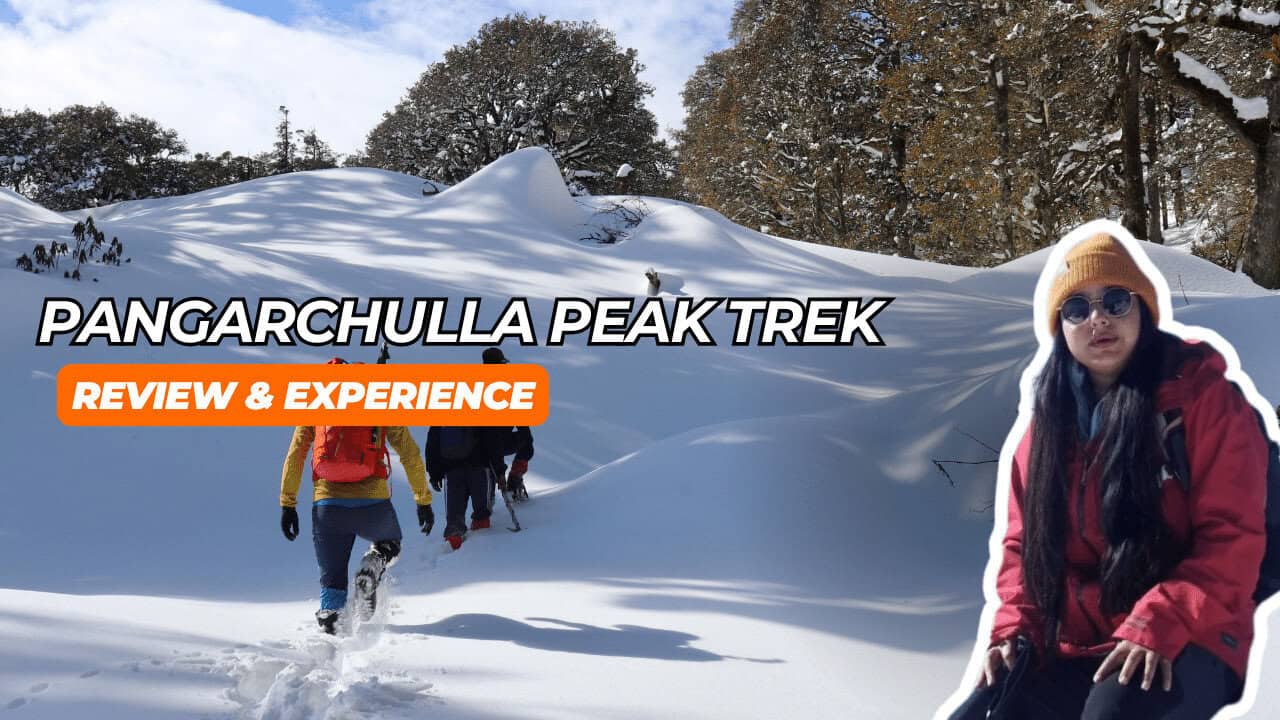
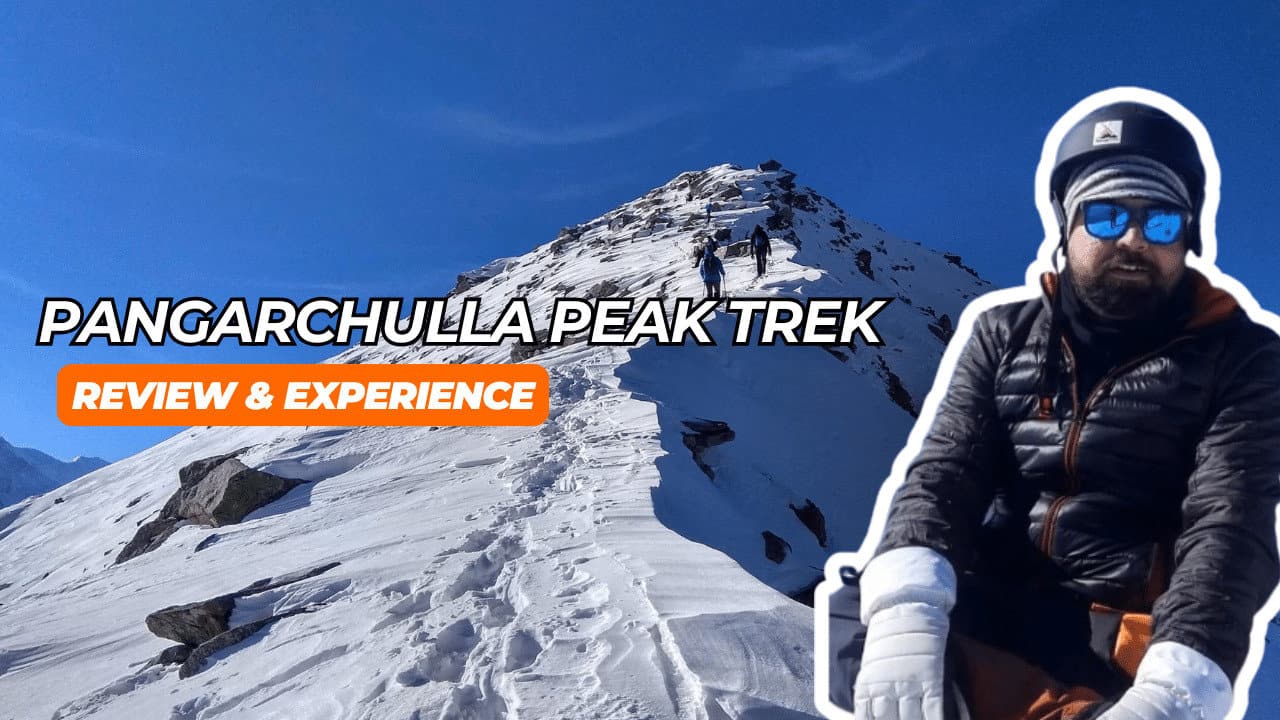

Food Provided by Us During Trek
We provide only Indian vegetarian food, and your meal will mainly consist of Indian bread, vegetables, lentils, rice, and a delicious dessert. During your trek, we will serve three meals a day, including breakfast, lunch, and dinner. You will also be served tea, snacks, and lip-smacking soup in the evening before dinner. If it is a long day of trekking, you will be given a packed snack.
After extensive research on the trekkers’ nutritional requirements, we prepare the menu. Before putting all the meals together, we also consider the altitude and the weather.
The meal we serve during the trek is perfectly balanced with calories, carbohydrates, vitamins, protein, fibre, and minerals. You need to know that all our cooks have great expertise in cooking and have undergone thorough training. So, get ready to enjoy delectable and lip-smacking dishes during your trek. You will be served with lemon tea in the tent to start your day with a refreshed feeling. Before leaving the campsite for trekking, you will be given a hot finger-licking breakfast like upma, Aallu Prantha, Besan Chilla, Poha, Daliya, Corn flakes, and Maggie, along with tea or coffee.
If your trek is longer, we also offer some fresh local fruits such as apples and healthy drinks like Frootie or Maaza. In the afternoon, you will be served a simple & healthy lunch, while at around 04:00 pm, you will be given tea and a light evening breakfast. After you reach your campsite at night, you will be served a hot and delightful dinner.
After reading this, you must have understood the food we provided on the trek; you don’t need to worry about food. Many trekkers repeatedly trek with us because of the food we provide. Thus, we will give you unforgettable experiences.
Safety During Pangarchulla Peak Trek

Trekking with us for the Pangarchulla Peak Trek is entirely safe because we have a team of trek leaders qualified in Wilderness first-aid and complete information about the high-altitude glitches. During the trek, we carry a full first-aid kit that contains all the essential medicines. Before trekking with us, you must ensure that you are medically fit for the trek; for us, your medical fitness is more important than anything else.
Right from our establishment, we at Trekup India have been continuously introducing new safety practices into Indian trekking to ensure the safety of voyagers. Trekup India introduced microspikes and made emergency bottled oxygen mandatory for all treks. Our trek leaders take your daily Pulse oximeter reading. We at Trekup India introduced the radio walkie-talkie as a safety communication device.
How can we ensure that your trek is safe with us?
We have noticed that most trek-organizing organizations do not follow these systems, but with time, they are following us; several competing companies are adopting these practices and organizing great, safe treks.
We ensure complete technical safety in the mountain. Our company has a vast team of more than 100 guides and trek leaders who serve on Himalayan treks. One of the best things about our team is that all the members are trained professionally by the Nehru Institute of Mountaineering, Indian Mountaineering Foundation Delhi, and Hanifle Center Outdoor Education Mussoorie.
Explore our New Safety Protocols
To ensure a perfect Trek, we have introduced some new safety checks to ensure excellent safety for our trekkers.
Our On-trek safety checks include:
- Daily oxygen saturation, along with pulse readings
- Stretchers team appointed on every trek
- Radios
- Trained mountain staff and complete safety
- Additional oxygen cylinders
- Special medical kit for high-altitude treks
- Microspikes on all types of snow treks
- Experienced Trek leaders, as well as safety
- Technical team on all snowy slopes
For Us, Your Safety Is the Top Priority
At Trekup India, you will find a team with local knowledge and fluency in English and Hindi. This helps ensure that you have a fantastic trek. Not only this, but we also pay attention to your health and safety because this is something we cannot ignore. All the team leaders involved in trekking have already undergone several professional courses in first aid, portable altitude chamber training, CPR, environmental awareness training, and advanced wilderness emergency medicine.
We also carry a complete first aid medical kit on every trek and trip we organize. Apart from the medical kit, we take a portable altitude chamber (if needed) and medical oxygen for all high-altitude treks. Our company has significant expertise in organizing all sorts of group adventure holidays for family groups, school and college groups, and friend groups. We have many travel options that suit different fitness levels and travelling styles.
Regardless of the group size, we value each and every member of our trekking groups. Our commitment to personal attention ensures that your needs and safety are always our top priority.
Who we are?
Trekup India has been a stalwart in the Adventure Tourism industry for 30 years. Since our inception, we have been dedicated to providing top-notch treks, voyages, trekking programs, and high-altitude expeditions. Our extensive experience is a testament to our commitment to your adventure and safety.
We organize treks in Uttarakhand, Kashmir, Sikkim, and Himachal while being part of the trekking community; we feature more than 75 documented Himalayan treks. In addition to other outdoor activities, our company also organizes trips for schools, colleges, and families.
Therefore, we maintain the quality of services offered to our valuable customers.
Must Read These Information Of Pangarchulla Peak Trek
Why You Should Do Pangarchulla Peak Trek
- The trek offers stunning views of the Greater Himalayan Range. As you ascend, you will be treated to breathtaking panoramas of the magnificent peaks nearby, including Hathi Parbat, Mana Mandir, Kamet, Nanda Devi, Dronagiri, Chaukhamba, and Ghori Parbat. These views are unmatched and rare in other Himalayan hikes.
- The journey to the summit is thrilling and demanding. It is known for its challenging ascent, with icy rocks, steep areas, and an elevation gain of 4,000 ft on the final day. This makes the trek exhilarating and full of adventure.
- The Khullara campsite is a unique experience in the Himalayas, with its open ground surrounded by lush forests and breathtaking mountain views. The vibrant blooming Rhododendrons in March and April add to its natural beauty, making it a transformative experience. Spending two days at this campsite, including an acclimatization day, adds to the exceptional trek experience.
Best time to do Pangarchulla Peak Trek
The ideal months for embarking on this trek are March and April, as these months offer the pleasant weather of spring.
How Difficult is the Pangarchulla Peak Trek
Pangarchulla Peak trek is a moderate trek. It involves challenging and uneven paths, reaches an altitude above 15,000 ft, requires up to 9 hours of trekking per day, has limited exit routes, and demands excellent cardiovascular fitness and prior high-altitude trek experience. The Pangarchulla Peak trek meets all these criteria, as the summit reaches 15,070 ft, and the summit day involves a strenuous 12-hour ascent and descent over a 4,000 ft aaltitude change. The summit climb features steep, irregular, and exposed sections, including the final 4 hours over hard snow and boulders. This part of the trek is challenging, exhausting, and risky, requiring constant vigilance, agility, and energy. Most trek days involve at least 6-7 hours of trekking, making it arduous. It’s important to note that undertaking this trek without prior high-altitude experience and proper physical conditioning is challenging and nearly impossible.
Mythological Stories About Pangarchulla Peak Trek
Frequently Asked Questions About Pangarchulla Peak Trek
What is the distance of the Pangarchulla Peak Trek?
The Pangarchulla Peak Trek covers approximately 37.5 kilometers along the scenic Auli–Pangarchulla Peak–Karchhi trail. The journey begins from Auli, near Joshimath, nestled in the Garhwal region of Uttarakhand. The trek itself spans five days, with a total duration of seven days when including travel time to and from Rishikesh. While the first two days feature relatively shorter hikes, the subsequent days demand greater endurance, with daily treks often exceeding 8 hours. The summit day is the most challenging, typically requiring around 12 hours of trekking through steep and rugged terrain.


